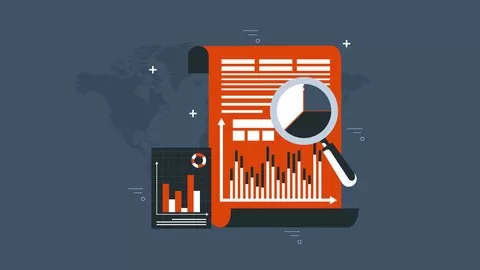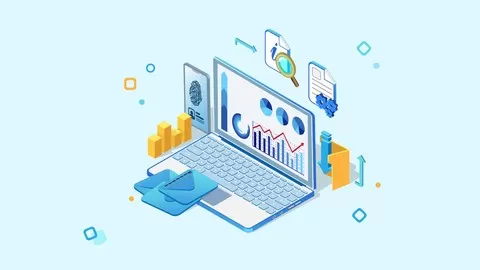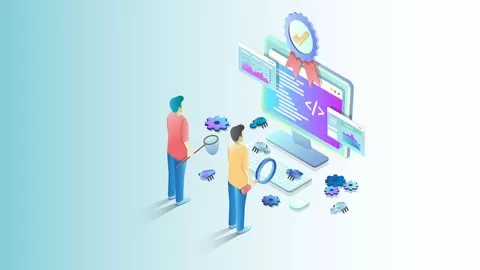Just watch 2 Preview video, and you will be clear that you want to go only with this Testing Course
——————————————————————————————————————————————————-
The course is designed keeping in mind that the users are:
New to the testing domain or
looking for a change from other domain to the testing domain or
has less than two years of experience in testing domain
——————————————————————————————————————————————————
Course Structure
This course has 4-levels :
Beginners level: Here you will understand the basics of the test, type and level of testing, basic testing techniques and essential testing tools. This course is perfect for some those who would like to kick start their testing career.
Agile Level: This is one of the popular concepts in testing and much in demand in testing industries. In this course, you will understand the concepts of Agile testing.
Advance level: This topic is a continuation of beginners level, but here we will practically apply the testing concepts on the requirement. This course is applicable for every tester as here you will learn how to apply testing techniques.
Expert level: This is the highest level in testing you can achieve. In this level, all different type of black box testing is explained with the practical requirement. Here you will learn how to analyze the requirement and then how to apply black box testing to it. Examples will be very high level. Each is every topic is covered depth knowledge of the topic.
——————————————————————————————————————————————————-
ALL-IN-ONE Software testing certification course
–> Study Lectures + Reference book + International syllabus PDF
–> 1000+ Examples and in-depth explanation to each topic .
–> HD videos – HD Audio (no power point style reading): Watch the preview lectures to get the feel.
–> Covers most essential aspects of testing
–> Course will be helpful throughout your testing career
—————————————————————————————————————————————————–
WHY ISTQB MASTERCLASS:
I am an “International Certified trainer” for below topic along with my authentication no*:
1. Certified ISO-26262 for functional safety testing
2. 87973 Foundation level
3. 108197 Advance level Technical Test Analyst
4. 116388 Advance level Test Analyst
5. 114710 Agile tester Extension
6. 117029 Model-based testing
(*you can put these no. in respective websites and find my details)
—————————————————————————————————————————————————–
COURSE CONTENT (international course for testing )
**************************** LEVEL – 1 ***********************************
Chapter 1 : Fundamentals of Testing
—-> What is testing
—-> Testing aptitude questions
—-> Why Testing
—-> Testing aptitude questions
—-> Principles of testing
—-> Testing aptitude questions
—-> Test Process
—-> Psychology of testing
—-> Testing aptitude questions
Chapter 2 : Software Testing Life-cycle Models
—-> Different models
—-> Test Levels
—-> Test Types
—-> Maintenance testing
Chapter 3 : Static Testing
—-> Static testing basics
—-> Benefits of static testing
—-> Review Process
—-> Review types
—-> Roles and responsibilities
Chapter 4 : Test Types
—-> How to choose test type
—-> Equivalence Partitioning
—-> Boundary Value Analysis
—-> Decision Table Testing
—-> State Transition Testing
—-> Use Case Testing
—-> Statement Testing and Coverage
—-> Decision Testing and Coverage
—-> Experience-based Test Techniques
Chapter 5 : Test Management
—-> Independent Testing
—-> Tasks of a Test Manager and Tester
—-> Configuration Management
—-> Risks and Testing
—-> Defect Management
Chapter 6 : Tool Support for Testing
—-> Test Tool Considerations
—-> Test Tool Classification
—-> Benefits and Risks of Test Automation
—-> Effective Use of Tools
—-> Pilot Projects for Introducing a Tool into an Organization
—-> Success Factors for Tools
**************************** LEVEL – 1 ***********************************
CHAPTER 1 : Agile Values
—-> 1 Agile-Value-1
—-> 2 Agile-Value-2
—-> 3 Agile-Value-3
—-> 4 Agile-Value-4
—-> 5 Agile-Manifesto
—-> 6 Overview
—-> 7 Benefits
—-> 8 Power-of-three
—-> 9 Overview
—-> 10 Benefits
—-> 11 Overview
—-> 12 Extreme-Programming-Values
—-> 13 Extreme-Programming-Guidelines
—-> 14 Extreme-Programming-Practices
—-> 15 Scrum-Overview
—-> 16 Scrum-Instruments-Part-1
—-> 17 Scrum-Instruments-Part-2
—-> 18 Scrum-role
—-> 19 KanBan
—-> 20 Overview
—-> 21 Poor-specification
—-> 22 User-Story-Creation
—-> 23 Agile-INVEST-TECHNIQUE
—-> 24 Agile-3-C-Concept
—-> 25 Retrospectives-Meeting
—-> 26 Continuous-Integration
—-> 27 Activities-of-continous-integration
—-> 28 Continuous-Integration-Build-Tool
—-> 29 Continuous-Integration-Benefits
—-> 30 Continuous-Integration-Risks
—-> 31 Release-and-Iteration-Planning
—-> 32 Testers-role-in-planning
—-> 33 Test-related-issue-in-planning
AGILE TESTING – Chapter 2
—-> 34 Agile-VS-Traditional-Approaches
—-> 35 Test-and-development-activities-PART-1
—-> 36 Test-and-development-activities-PART-2
—-> 37 Test-and-development-activities-PART-3
—-> 38 TEST-LEVELS
—-> 39 Project-Work-Products
—-> 40 BUSINESS-ORIENTED-WORK-PRODUCTS
—-> 41 DEVELOPMENT-WORK-PRODUCTS
—-> 42 TEST-WORK-PRODUCTS
—-> 43 TESTING-Overview
—-> 44 Automated-test-Goal
—-> 45 Automated-test-Benefits
—-> 46 Skill-Of-tester
—-> 47 Role-of-tester
—-> 48 Test-related-risk
AGILE TESTING – Chapter 3
—-> 49 overview
—-> 50 Test-Driven-Development
—-> 51 Acceptance-Test-Driven-Development
—-> 52 Behavior-Driven-Development
—-> 53 The-Test-Pyramid
—-> 54 Testing-Quadrants
—-> 55 The-Role-of-a-Tester-teamwork
—-> 56 The-Role-of-a-Tester-Sprint-Zero
—-> 57 Agile-Testing-Practices
—-> 58 Assessing-Quality-Risks
—-> 59 Quality-risk-analysis-process
—-> 60 Estimating-Testing-Effort-Technique
—-> 61 Estimating-Testing-Effort-Process
—-> 62 Techniques-in-Agile-Projects
—-> 63 Test-bases
—-> 64 Acceptance-Criteria-Factors
—-> 65 Definition-of-done-Test-Level
—-> 66 Definition-of-done-user-story
—-> 67 Definition-of-done-Release
—-> 68 Acceptance-Test-Driven-Development
—-> 69 Functional-and-Non-Functional-Overview
—-> 70 Functional-Testing-Overview
—-> 71 Functional-Testing-Coverage
—-> 72 Non-functional-Testing-OverView
—-> 73 Non-functional-Testing-Coverage
**************************** LEVEL – 3 ***********************************
ADVANCED LEVEL : Chapter 1
—-> 2 Introduction
—-> 3 Risk Identification
—-> 4 Risk Assessment – Overview
—-> 5 Risk Assessment – Factors
—-> 6 Risk Mitigation
—-> 7 Risk Definitions
ADVANCED LEVEL : Chapter 2
—-> 1 Introduction chapter 2
—-> 2 Condition testing
—-> 3 Condition testing – EXAMPLE
—-> 4 Decision testing
—-> 5 Decision testing – EXAMPLE
—-> 6 Condition Vs Decision testing
—-> 7 condition vs Decision testing – EXAMPLE
—-> 8 MC-DC Testing – EXAMPLE
—-> 9 MC-DC Testing
—-> 10 Multiple condition Testing – EXAMPLE 2
—-> 11 Multiple condition Testing – EXAMPLE
—-> 12 Multiple condition Testing
—-> 13 PATH Testing
ADVANCED LEVEL : Chapter 3
—-> 9 Introduction
—-> 10 Static testing vs dynamic testing
—-> 11 Static Testing Basics
—-> 12 Control Flow Analysis – Overview
—-> 13 Control Flow Analysis – EXAMPLE-1
—-> 14 Control Flow Analysis – EXAMPLE-2
—-> 15 Control Flow Analysis – USE
—-> 16 Flow Chart – Basics
—-> 17 Cyclomatic Complexity
—-> 18 Cyclomatic Complexity Example – 3
—-> 19 Cyclomatic Complexity Example-2
—-> 20 Data Flow Analysis – Overview
—-> 21 Data Flow Analysis – Anomalies
—-> 22 Data Flow Analysis – Facts
—-> 23 Data Flow Analysis – EXAMPLE-1
—-> 24 Data Flow Analysis – EXAMPLE-2
—-> 25 Maintainability Overview
—-> 26 Static Analysis – EXAMPLE
—-> 27 Static Analysis – Module Design
—-> 28 Static Testing Basics
—-> 29 Call graph – Overview
—-> 30 Call graph – USES
—-> 31 Integration Testing types
—-> 32 Pairwise – Overview
—-> 33 Neighborhood – Example
—-> 34 Neighborhood – Overview
—-> 35 Neighborhood – Summary
—-> 36 Pairwise – Example
—-> 37 Pairwise – Summary
—-> 38 Dynamic analysis – Overview
—-> 39 Dynamic analysis – Introduction
—-> 40 Dynamic analysis – Important
**************************** LEVEL – 4 ***********************************
EXPERT LEVEL : Chapter 1 : Testing process
—-> 1 Introduction Chapter 1
—-> 2 Test Analyst Involvement
—-> 3 Recall from foundation level
—-> 4 Sequential-development-model
—-> 5 Incremental-development-model
—-> 6 Iterative-development-model
—-> 7 Test level align with Test process
—-> 8 Test Analysist involvement wrt development model
—-> 9 Next lectures
—-> 10 Test Process_FL
—-> 11 Test Planning_FL
—-> 12 Test Planning
—-> 13 Test Monitoring and control_FL
—-> 14 Test Monitoring and control
—-> 15 Test Analysis – Objective_FL
—-> 16 Test Analysis – Activities_FL
—-> 17 Test Analysis – Importance_FL
—-> 18 Test Analysis
—-> 19 Test design – Objectives
—-> 20 Test design – Activities
—-> 21 Test design – Importance
—-> 22 Test design
—-> 23 Concrete and Logical TestCases
—-> 24 Creation of Test Cases
—-> 25 Test Cases and Test Levels
—-> 26 Test Case documentation
—-> 27 Test implementation – Objective
—-> 28 Test implementation – Activities
—-> 29 Test Implementation
—-> 30 Test Environment
—-> 31 Test Analyst involvement
—-> 32 Test Execution
—-> 35 Exit Criteria and Reporting
—-> 36 Test Closure Activities
EXPERT LEVEL : Chapter 1 : Test Analysts involvement
—-> 1 Introduction Chapter 2
—-> 2 Test Progress Monitoring and Control – Part 1
—-> 2 Test Progress Monitoring and Control – Part 2
—-> 4 Effective communication
—-> 5 Risk Based Testing Introduction
—-> 6 Risk Identification
—-> 7 Risk Assessment
—-> 8 Risk level
—-> 9 Risk Mitigation
—-> 10 Risk calculation use
EXPERT LEVEL : Chapter 3 :3 Test Techniques
—-> 1 Introduction Chapter 3
—-> 2 Specification-Based Techniques
—-> 3 Equivalence Partitioning – Definition
—-> 4 Equivalence Partitioning – Theory
—-> 5 Equivalence Partitioning – EXAMPLE 1
—-> 6 Equivalence Partitioning – EXAMPLE 2
—-> 7 Equivalence Partitioning – EXAMPLE 3
—-> 8 Equivalence Partitioning – EXAMPLE 4
—-> 9 Equivalence Partitioning – EXAMPLE 5
—-> 10 Boundary Value Analysis – Definition
—-> 11 Boundary Value Analysis – Theory
—-> 12 Boundary Value Analysis – EXAMPLE 1
—-> 13 Boundary Value Analysis – EXAMPLE 2
—-> 14 Boundary Value Analysis – EXAMPLE 3
—-> 15 Boundary Value Analysis – EXAMPLE 4
—-> 16 Decision Tables – Definition
—-> 17 Decision Tables – Practical example
—-> 19 Decision Tables – EXAMPLE 1
—-> 20 Decision Tables – EXAMPLE 2
—-> 21 Decision Tables – EXAMPLE 3
—-> 22 Decision Tables – EXAMPLE 4
—————————————————————————————————————————————————–
•Do you want to become a certified tester?
•Want to get in-depth knowledge of testing ?
•Are you looking for JOB?
•Do you want to switch testing job?
•Preparing for testing interview ?
•Are you a student / professional who what to make career in Multinational company ?
•you want to understand testing concept from in-n-out ?
Then this is the end for your search!!
—————————————————————————————————————————————————–
ABOUT COURSE
This course is designed for the students or professional who are looking for job in testing.
Course will take you through the different aspect of testing and it will make sure your will be getting what you want.
Highlights of the Testing course:
•1. It is designed based on the “The International Software Testing Qualifications Board® (ISTQB®) “
•2. it contains 1000+ real testing environment example to bring concept near to the real environment.
•150+ Study material to help you understand the testing knowledge in depth
•Prepare you for the ISTQB certification so that , not only you get the Testing knowledge but an international testing certificate.
What are you waiting for enroll to the course and become the Certified tester.






